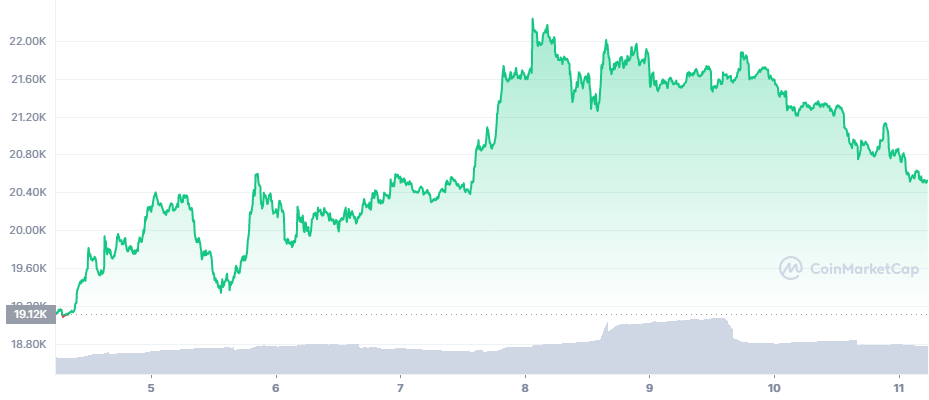Bitcoin (BTC) Range-Bound, Price Bottom Still in Doubt

Bitcoin (BTC) rallied close to $22,000 over the weekend, after reaching a high of $22,314.94 last Friday. The leading coin, however, stepped back under $21,000 ahead of the new trading week, once again posing a question of whether the fallout was over, or whether new lows were coming.
During the past few weeks, BTC bounced from levels close to the 2017 peak, and moved according to the Rainbow Chart, remaining above $19,000. At these levels, there is a mix of advice, from calling the bottom to predicting another rapid dip to a lower range.
The Crypto Fear and Greed index also indicates the worst may be over for BTC and altcoins as it moved to 24 points. This is still in the range of extreme fear, but far from the all-time low of 6 points at the end of June.
The BTC market cap dominance expanded to 44.2%, displacing both Ethereum (ETH) and altcoins.
BTC spent months with a mix of retail buying, growing whale wallets, and robust competition between miners. At the same time, the market was pressured by macro factors, including expectations of a more hawkish interest policy for the US Fed and the European Central Bank. Overall global uncertainty is also raising questions of the real versus speculative value of BTC.
BTC has mostly absorbed the fallout of Terra LFG, the problems of Celsius, and the bankruptcy of Three Arrows Capital. Liquidity is returning only slowly, to around $28B in 24 hours for BTC. Altcoins, as a more volatile asset, had short-term rallies as a source of fast earnings. But the BTC price remains a leading indicator of sentiment. For riskier traders, some of the altcoins may offer significant opportunities for fast growth.
Tether Brings Higher USDT Supply
Tether (USDT) is having a supply boost, just days after sinking under 65B tokens. Now, USDT is back to 65.9B tokens, accomplishing a weekend turnover of $38B.
Recently, Tether, Inc. reassured markets that it has not been pressured by its exposure to Celsius. The company liquidated a $1B in USDT, meaning it took the collateral of $1.3B in BTC equivalent.
For now, it is uncertain at what BTC price the loan was granted, but Tether reassures that the exposure to Celsius is limited and will not affect the overall backing of USDT.
The crypto community also found it problematic that Tether was issuing new USDT based on a BTC collateral. Such a move could be considered another circular funding approach, somewhat similar to Terra LFG. Even with an over-collateralized loan, BTC remains too volatile to defend a stablecoin.
Additionally, Tether has promised not to issue crypto-backed USDT and thus end up with no truly liquid collateral in cash-like assets.
If Tether, Inc. issues BTC-backed loans, its approach becomes somewhat similar to algorithmic stablecoins. For now, the stability of those assets is still in question, after the failure of UST to keep its peg.
Celsus has not communicated any of the issues and has taken almost a month of no withdrawals. Additionally, recently the company regained access to more than $450M in BTC, though still a smaller loan compared to the Tether, Inc. collateral.
Celsius has not announced insolvency, though its model of high interest rate has been deemed unsustainable. For now, Celsius is a side factor, with no direct tools to affect the market.
Will 140K BTC Hit the Market
For years, there has been an expectation that eventually, the Mt. Gox stash of coins would be returned to its owners.
Now, there is again a high probability the event happens relatively soon. Even at these prices, BTC may be sold to realize profits after years of forced holding.
The Mt. Gox stash of coins is similar to a large-scale whale wallet, and about twice as large as the BTC holdings of Terra LFG. A rapid sale on the spot market could depress BTC prices. However, the same scenario has been mentioned multiple times and for now, the coins held by the Mt. Gox trustees are not facing a clear deadline for distribution.
However, the coins may take longer to move to markets, as the previous traders may not be technically ready to trade immediately, or may intend to hold onto the assets. Yet this July 6, Mt. Gox creditors received the first official communication on an upcoming coin distribution.
Even with a relatively small sale of coins, some bought at lows between $50 and $200, the current BTC price may crash significantly. For now, it is encouraging the BTC retained from Mt. Gox will be returned to wallets, and not liquidated and paid in cash as previously suggested.

Uphold makes buying crypto with popular currencies like USD, EUR and GBP very simple with its convenient options to swap between crypto, fiat, equities, and precious metals.

With over 50 coins and an obsession with security, Kraken is one of the safest places to buy and trade crypto.

Kraken has a good reputation for security and protection of your funds and operates across the USA (except NY), Canada, the EU and Japan

Based in Charleston, South Carolina. Serves over 184 countries and has done over $4 billion in transactions. Offers convenient options to swap between crypto, fiat, equities, and precious metals.

Is mining crypto still profitable? With more cryptos like Ether switching to POS is the competition going to get too much?

Crypto gets a lot of criticism sometimes but what sort of job are the current banks doing at looking after their customers. Who are the best and the worst banks to be with?

An early alternative to Bitcoin, LTC aimed to be a coin for easy, fast, low-fee spending. LTC offers a faster block time and a higher transaction capacity in comparison to Bitcoin.

The leader in programmable money, smart contracts and decentralised applications. There have been many copycats but none have the community and level of adoption.